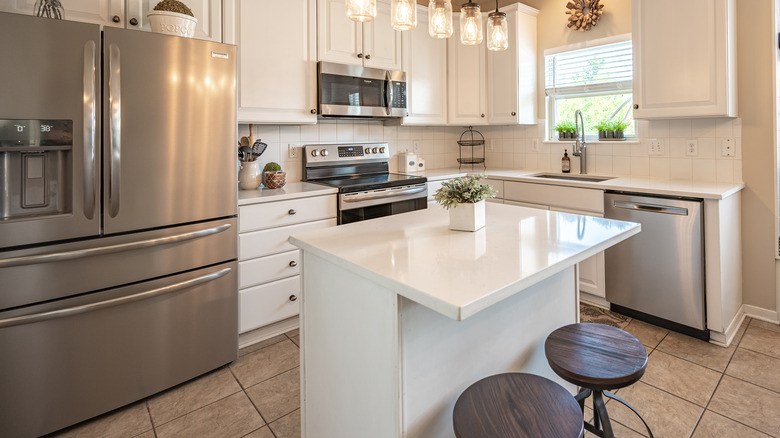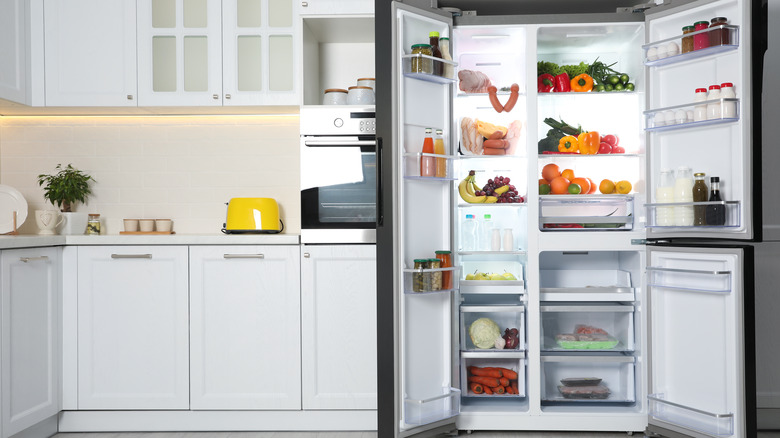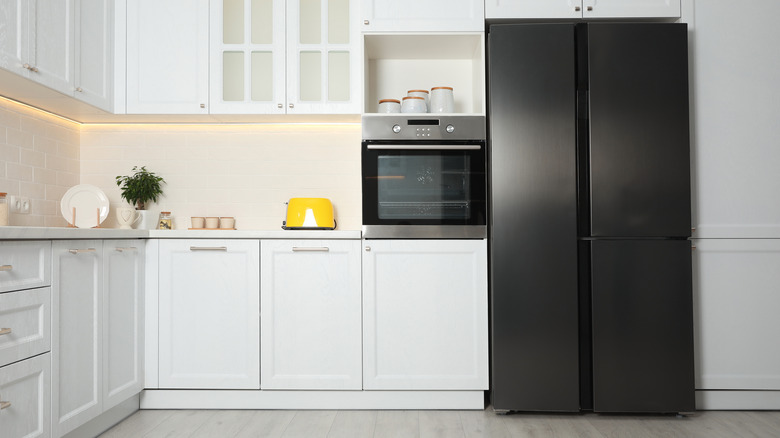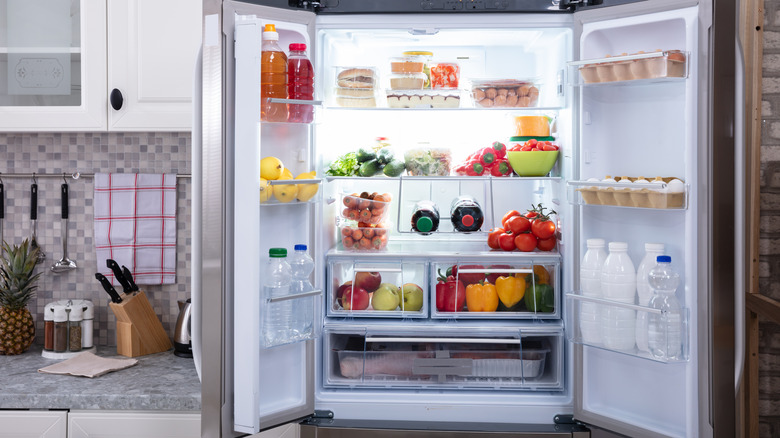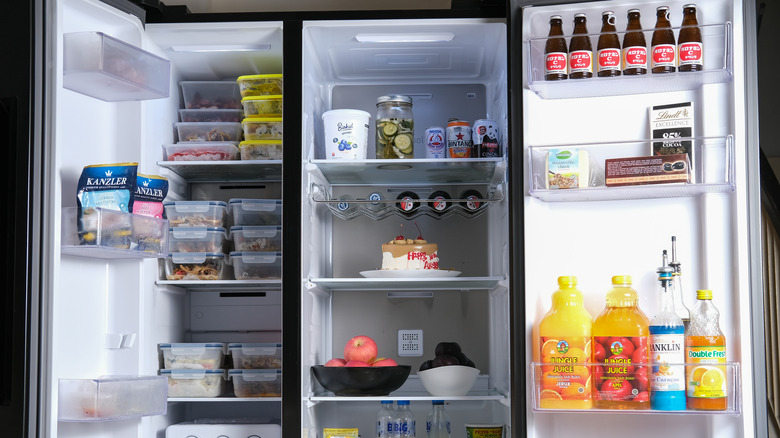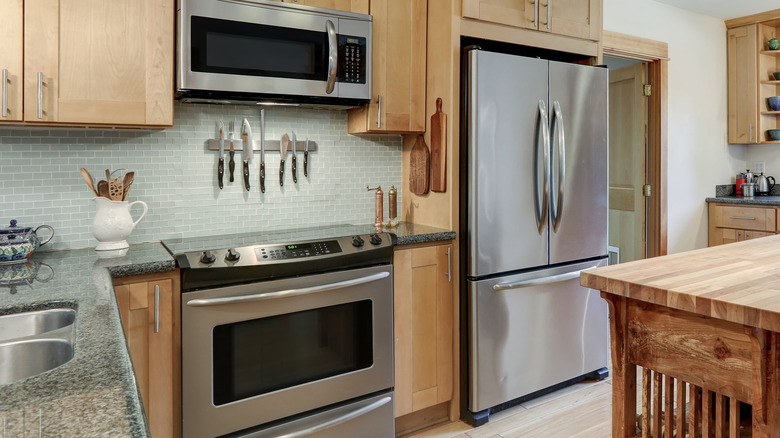Side-By-Side Vs. French Door Refrigerators: What's The Difference?
Buying any household appliance can be a stress-inducing decision, especially when it comes to refrigerators. With their high price point and multiple designs, it can feel like there is an endless list of options with no clear, definitive answer. In most modern kitchens, however, homeowners are usually stuck between two of the most popular styles of fridges: side-by-side door refrigerators, and French door refrigerators.
As the name would suggest, with side-by-side refrigerators the freezer and fridge doors are next to each other, offering similar sized compartments with vertical shelving, explains KitchenAid. French door refrigerators, on the other hand, have two doors on the top, which both open up to the fridge section and a deep, pull-out freezer at the bottom. Some models have an additional, middle drawer that can be set to various food-specific temperatures for chilling things like drinks, salad produce, or cheese.
How does the appearance differ?
One of the many differences between a side-by-side and a French door refrigerator is the appearance in design. Elements like construction materials, finish, and size are relatively similar in terms of options and depend on the brand and model. The body of the kitchen appliance is where things start to get really different, though. As Whirlpool notes, side-by-side door refrigerators have two, long, vertical doors next to each other. One side is for refrigerated items, and the other side is for frozen items. It can also have additional features, like ice cube makers or a display screen, and variations in ratios.
Conversely, French door refrigerators are horizontally focused and have more variations in design. They always have at least two sections; a refrigerated compartment on top with two doors opening out, and a shorter pull-out freezer on the bottom. Some models have additional middle drawers for specific refrigeration requirements. Like the side-by-side models, French door fridges can include upgrades like a drinks dispenser, an ice cube maker, or a digital display screen.
Pros and cons of side-by-side refrigerators
One major advantage of a side-by-side door refrigerator is that there is more freezer space, as well as more easily accessible shelves, compared to a pull-out model, explains KitchenAid. You can usually move the shelves around or remove them completely, making it easier to organize your products and lay them out in a visually cohesive way. Side-by-side models also tend to have narrower doors that don't swing out as far, making them ideal for tighter spaces. Perhaps most importantly, they tend to have a much cheaper starting price than French door models.
That being said, side-by-side door refrigerators aren't perfect, and there are some negatives to consider. While vertical storage in a freezer may be preferable to some, it limits your ability to store wider items. If a freezer is too narrow, common frozen items like pizzas may have to be awkwardly crammed in. Likewise, if you enjoy baking or cooking, you'll likely have a hard time storing bowls and baking trays in there, too. In addition, since everything is vertical, you may find yourself bending down a lot more to access items.
Pros and cons of French door refrigerators
Similarly, there are a variety of advantages and disadvantages to French door refrigerators. According to KitchenAid, many homeowners prefer the French door model over the side-by-side design due to how easy it is to store and access fresh, refrigerated foods. With wider shelves and a focus on storage, it becomes much easier to see all your food. You also don't have to bend down as often to access it. While side-by-side models occasionally come with an ice and water dispenser, French door fridges almost always come with them.
However, one major drawback is the freezer design. They tend to be smaller by volume than the freezers in side-by-side models. On top of that, they're not the best for organizing and seeing your food. Often, it's necessary to pile your frozen food on top of itself, and you may end up forgetting about or neglecting the items at the bottom.
What are the differences in cost?
One of the differences between the side-by-side door design and the French door refrigerator is the price point. With both models, you can, of course, opt for the top-of-the-line models that include features like a touch screen display, an ice and water dispenser, and more. However, for the most basic models, French door refrigerators tend to be more expensive.
For example, a side-by-side door refrigerator from Whirlpool that is 36 inches wide, contains 28 cubic feet of space and comes in a fingerprint-resistant, black stainless steel finish costs just $2,199. However, a French door refrigerator, also from Whirlpool, which is the same width and color, and has 25 cubic feet of storage, is $2,799. The only difference, besides the $600 price increase, is the design and style of the doors.
When to choose a side-by-side over a French door refrigerator
Both the side-by-side design and the French door refrigerator have valid pros and cons. Ultimately, though, it comes down to where you're putting the fridge, your budget, and your visual preference. As CNET notes, both styles of refrigerators are great for narrow spaces, as the doors don't tend to swing out wider than the fridge itself. That being said, you should opt for a side-by-side design if your kitchen is too skinny to pull out the freezer drawer in a French door model. You should also choose a side-by-side door refrigerator over a French door design if you're on a tight budget for your kitchen remodel.
It is also beneficial to consider how you want your food to be laid out. If you don't mind having a narrow freezer, then the side-by-side model is probably for you. If you don't want to have to sift through a deep basin freezer to look for your food, it's probably for you, too. However, if you don't want to bend over to reach your food, or you don't need the additional freezer space, then perhaps opt for a French-style refrigerator.
